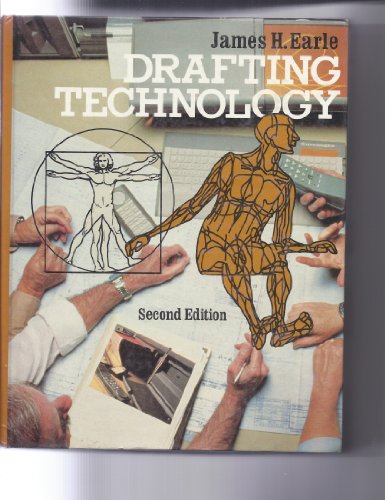Drafting technology - Softcover

"synopsis" may belong to another edition of this title.
Graphics Technology covers the principles of engineering graphics and graphical problem solving for courses in two-and four-year programs. Its content is based on the needs of industry and is presented in a classroom-tested format that is as functional and understandable as possible. Content
The major areas of engineering graphics that this text presents are:
working drawings
descriptive geometry
computer graphics
introductory design
specialty areas
communications in general
Knowledge of all of these areas is important to the career of the engineer, technologist, and technician.
The principles of working drawing preparation area based on the ANSI standards, and include dimensioning, tolerances, welding, and material specifications. Descriptive geometry principles are covered to aid three-dimensional problem solving and spatial analysis.
Chapter 30 gives an overview of two-and three-dimensional computer graphics. Introductory design is covered in Chapter 2, along with design problems that can be assigned as projects. Specialty areas of pipe drawing, electronic drawing, technical illustration, data analysis, and nomography are included to broaden the students' understanding of graphics technology. Format Features
Graphics Technology has been designed to be as teachable as possible by including a number of features that make teaching easy for the teacher and learning easy for the student. These features are especially useful when students are working and studying on their own without the help of their teacher.
Features that help this learning transfer include:
A second color which highlights steps in the solution
Clear, teachable examples that assist with visualization
Problems and examples that are presented using step-by-step illustrations
Key points noted on the illustrations
Human figures that show viewpoints
Industrial examples which make problems meaningful A Career Reference Book
Some materials in this book may not be covered in the course for which it is used due to time limitations or the emphasis of the course by the instructor. Because the course may be the only graphics course that a student will encounter, this book should be retained for reference.
An engineering drawing is not just a document that is essential for a project to become a reality; it is a legal contract. As such its preparation must adhere to strict standards and be as clearly prepared as possible. Students can use this book as a reference throughout their professional careers. A Learning System
This book can be used in combination with the supplements listed inside the back cover to create a complete teaching system.
Textbook Problems
Over 500 problems are available to aid the student in mastering important concepts.
Problem Manuals
Nineteen problem books and guides (with outlines, problem solutions, tests, and test solutions) are available for use with this book, and new problem books will be introduced in the future. Fifteen of the manuals include computer graphics versions of the exercises on the backs of the problem sheets, allowing the student to find the solution to each problem by both computer and pencil. Acknowledgments
We are grateful for the assistance of many who have influenced the development of this volume. Numerous industries have furnished photographs, drawings, and applications that have been acknowledged in the corresponding legends. The Engineering Design Graphics staff of Texas A&M University have been helpful in making suggestions for this book. Professor Tom Pollock provided valuable information on various metals in Chapter 12.
We are indebted to Neal Alen, Rodger Payne, and Jimm Meloy of AutoDesk, Inc. for their assistance with AutoCad®. We appreciate the assistance of Karen Kershaw of MegaCADD, Inc. David Ratner of Biomechanics Corporation was helpful in providing HUMANCAD® software.
We are appreciative of the many institutions that have though enough of our publications to adopt them for classroom use. It is an honor for one's work to be accepted by colleagues. We are hopeful that this textbook will fill the needs of engineering and technology programs. As always, comments and suggestions for improvement and revision of this book will be appreciated.
College Station, Texas
Jim Earle
Providing content for today's course that will fit tomorrow's needs, this new edition of Graphics Technology illustrates and presents fundamental concepts in an understandable format, reducing the amount of classroom tutoring needed.
Major content areas covered are:- Design and Creativity—New design examples from industry, examples of worksheets, and assignments make the process fun and encourage creativity and intuition.
- Computer Graphics—An introduction to AutoCAD 2005 provides step-by-step instruction for two-dimensional and three-dimensional computer graphics by AutoCAD.
- Engineering Drawing—Illustrations separated into multiple steps present the concepts as clearly and simply as possible, utilizing a second color to emphasize sequential steps, key points, and explanations.
- Descriptive Geometry—Three-dimensional spatial analysis principles are covered to enable the student to apply them to industrial applications at the end of these chapters.
- Problem Solving—Over 600 problems are offered to aid the student in mastering the principles of graphics and design.
Graphics Technology will continue to serve as a permanent reference for the engineer, technologist, or technician.
"About this title" may belong to another edition of this title.
- PublisherAddison-Wesley
- Publication date1986
- ISBN 10 0201102390
- ISBN 13 9780201102390
- BindingPaperback
- Edition number2
- Number of pages775
- Rating
Buy New
Learn more about this copy
Shipping:
US$ 6.65
Within U.S.A.
Top Search Results from the AbeBooks Marketplace
DRAFTING TECHNOLOGY
Book Description Condition: New. New. In shrink wrap. Looks like an interesting title! 3.4. Seller Inventory # Q-0201102390
Drafting technology
Book Description paperback. Condition: New. New. book. Seller Inventory # D8S0-3-M-0201102390-6

